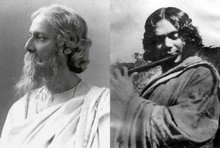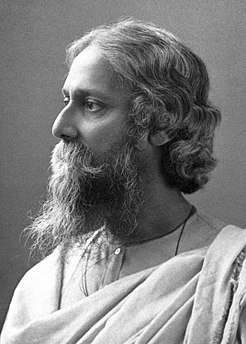Bengali poetry
| Bengali literature বাংলা সাহিত্য | |
|---|---|
 | |
| Bengali literature | |
|
By category Bengali language | |
| Bengali literary history | |
| History of Bengali literature | |
| Bengali language authors | |
| Chronological list – Alphabetic List | |
| Bengali writers | |
| Writers – Novelists – Poets | |
| Forms | |
| Novel – Poetry – Science Fiction | |
| Institutions and awards | |
|
Literary Institutions Literary Prizes | |
|
Related Portals | |
| Part of a series on the |
| Culture of Bengal |
|---|
 |
| History |
|
Mythology and folklore |
| Cuisine |
|
History
Genres Institutions
Awards
|
|
Music and performing arts Folk genres Devotional Classical genres Modern genres People Instruments Dance Theater Organizations People |
|
Bengali poetry is a form that originated in Pāli and other Prakrit socio-cultural traditions. It is antagonistic towards Vedic rituals and laws as opposed to the shramanic traditions such as Buddhism and Jainism. However the modern Bengali owes much to Sanskrit.
Early history
The history of Bengali poetry underwent three successive stages of development: poetry of the early age (like Charyapad), the Medieval period and the age of modern poetry. Modernity was introduced into Bengali poetry in the 1930s.
Origins
Bengali poetry probably began during the 10th century. It is known for the mystic poems called Charyacharyavinishchaya, and sometimes called Charyapad or Charyagiti. These poems were discovered in Nepal's Royal Library by Bengali scholar Mahamahopadhyay Haraprasad Shastri.
Translation of Epics into Vernacular
- Krittibas Ojha
- Kashiram Das
The Medieval period of Bengali poetry was between 1350 and 1800. It was known as the period of Jayadeva, the renowned 12th-century poet from neighboring Odisha who was famous for his poem Gitagovinda.
Other noted poets from this period include 13th century Vidyapati, known for his love lyrics and Baḍu, Chandidas, writer of Sri Krishna Kirtan. Sri Krishna Kirtan is considered to be the most important philosophical and erotic work of the period.
The period from 1500 to 1800 is known as the Late Middle Bengali Period. During this period, there was a marked influence of Chaitanya, leading to the development of Vaishnava literature. Vaishnava poets include Govinddas and Gyandas.
Beside Vaishnava poetry, the most significant work of the 16th century was Mukunda Chakravarti's Chandimangal. Other Mangal-Kāvyas or religious texts are Manasamangal, Dharmamangal and Phullaketu.
Two of Bengal's most well known Muslim poets, Daulat Qazi and Alaol, lived in the 15th century (1607–1680) in Myanmar.
Birth of modern poetry

Bharat Chandra marks the transition between Precolonial theocentric poetry and modern poetry. Iswar Gupta, Michael Madhusudan Dutta (1834–1873), Biharilal Chakravarti (1834–94), Rabindranath Tagore(1861–1941) are noteworthy poets of this period.
Modern Bengali poetry
With Rabindranath Tagore founding a firm basis for modern Bengali poetry, the new poets of the early 1920s consciously moved for transcending the frontiers of traditional verses to establishing a realm of truly modern poetry. It was a successful movement that brought permanent change to the structure and theme of poetry. Kazi Nazrul Islam (1899-1976) first built the foundation of modern Bengali poetry by introducing modern concept of revolt against all autocracy, hypocrisy, superstition and inhumanity in Bengali. One notable sect of modernists included pro-socialism poets like Sukanta Bhattacharya and Samar Sen.
Modern Bengali poetry has also witnessed feminist intellect Kabita Singha, mallika Sengupta, Krishna Basu and Sriparna Bandyopadhyay being some of the most prominent names.